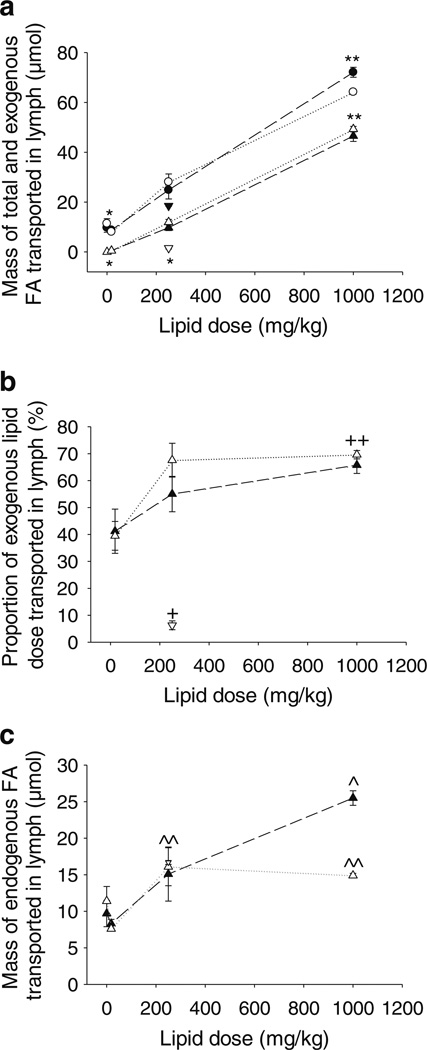Fig. 3.
Mass transport of lipids into the lymph over 8 h following intra-duodenal administration of halofantrine (Hf) in 18.1, 250 or 1,000 mg/kg oleic acid or 250 mg/kg capric acid containing formulations to mesenteric lymph duct cannulated male or female mice. (a) Mass of total fatty acid (FA, males black circle, females white circle) and mass of exogenous FA (males black triangle, females white triangle) transported into lymph (µmol) of oleic acid dosed animals, and mass of total FA (males inverted black triangle) and mass of exogenous FA (males inverted white triangle) transported into lymph (µmol) of capric acid dosed animals. (b) Proportion (%) of the exogenous FA dose transported into lymph in oleic acid (males black triangle, females white triangle) or capric acid (males inverted white triangle) dosed animals. (c) Mass of endogenous FA transported into lymph (µmol) in oleic acid (males black triangle, females white triangle) or capric acid (males inverted white triangle) dosed animals. Data represent mean ± SEM, n=3–5 per group. * Significantly lower in animals of the same sex administered saline, 18.1 mg/kg oleic acid or 250 mg/kg capric acid when compared to 250 or 1,000 mg/kg oleic acid (p<0.05), **Significantly greater in animals of the same sex administered 1,000 mg/kg oleic acid when compared to saline, 18.1 or 250 mg/kg oleic acid or 250 mg/kg capric acid (p<0.05), + Significantly lower in male animals administered capric acid when compared to any dose of oleic acid (p<0.05), ++ Significantly greater in animals of the same sex administered 1,000 mg/kg oleic acid when compared to 18.1 mg/kg oleic acid or 250 mg/kg capric acid (p<0.05), ^ Significantly greater in male animals administered 1,000 mg/kg oleic acid when compared to saline or 18.1 mg/kg oleic acid (p<0.05), ^^Significantly greater in female animals administered 250 or 1,000 mg/kg oleic acid when compared to 18.1 mg/kg oleic acid (p<0.05).

